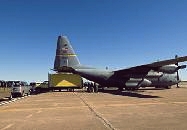
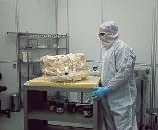
- - text and links as of last publication / le texte et les liens en l'état lors de la dernière publication - -
 |  | The Stardust samples canister arriving at Ellington Airfield, near the Johnson Space Center, Jan. 17, 2006 (left). The samples, out of the canister are beginning to be handled by Houston scientists (right). pictures NASA |
After that the Stardust sample return capsule successfully parachuted back Earth, touching down at 10h 10 GMT (3:10 a.m. EST) lastSunday, January 15th, in the desert salt flats of the Utah Test & Training Range, the deep space samples, after a first treatment at the Utah Test & Training Range, have been safely shipped to NASA's Johnson Space Center, Houston, aboard a C-130 aircraft. Scientists in Houston have now begun to process the cometary and interstellar dust samples.
The capsule re-entry had unfolded like planned, with a fiery plunge into Earth's atmosphere and a parachute-assisted landing at the Utah Test & Training Range. The Stardust mission had successfully performed several trajectory correction maneuvers to be able to release the sample return capsule on a due path, as Stardust itself eventually performed a deflection maneuver to avoid Earth. Stardust is now on an heliocentric orbit. The interstellar and cometary samples date back to the origin of the solar system. NASA's JPL, Pasadena, Calif. was managing the mission as Lockheed Martin Space Systems had developed and operated the spacecraft. The mother craft has been placed into a long-term hibernation, all but a few essential systems, such as Stardust's solar arrays and receive antenna, having been deactivated. This will allow to preserve any future re-use of the craft in the future. (last updated: January 18th, 2006)
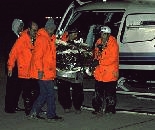 | 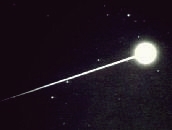 | The Stardust sample return capsule arriving at the Utah Test & Training Range inside a protective covering (left); Stardust sample return capsule seen near the end of its trajectory on Sunday, Jan. 15. The picture was taken aboard NASA's DC-8 Airborne Laboratory which had as a mission to study the skyconditions instead, from the light emitted by the fireball (right). pictures NASA (left), NASA Ames Research Center (right) |
->the Hypervelocity reentries section at NASA are collecting reports of observations about the re-entry. see more at their site
 | artist's illustration of the Stardust's sample return capsule parachuting. NASA/JPL-Caltech |
Sample Return Capsule Return Scheduled Jan. 15, 2006! Stardust is now preparing for the final phase of its mission, as it's scheduled to parachute over the Utah Test & Training Range next January 15th, 2006. Trajectory Correction Maneuvers (TCMs) are planned ahead this date to ensure that the spacecraft is correctly aimed at Earth before releasing the sample return capsule. A helicopter crew (or special off-road vehicles in case of bad weather) will retrieve the capsule with special precautions concerning the danger of potential gases. The capsule will be then moved to the U.S. Army Dugway Proving Ground, Utah, for initial processing, as the samples will be moved later to a special laboratory at NASA's Johnson Space Center, Houston, where they will be preserved and studied. The cometary particles will provide unique chemical and physical information about the time when the planets of the solar system formed. Most of the particles should be no more than a third of millimeter across. Scientists will slice them into even smaller pieces for study NASA, on the other hand, did not release any hint at whether the re-entry will be visible from the ground. Its path is taking the sample return capsule above the western part of the USA. Stardust sucessfully encountered comet Wild-2 on Jan. 2nd, 2004
see a detailed timeline of the sample capsule's return to Earth
Stardust will be the first mission, since the Apollo missions, to return extraterrestrial material to Earth. Stardust launched on February, 27th 1999 from the Kennedy Space Center (KSC). It used one gravity-assisted fly-by at Earth in January 2001, increasing its speed as well as its orbit's elongation. On its way to Wild-2, Stardust studied and collected interstellar dust twice, as in November 2005 the probe passed 1,900 miles (3,000 km) away from the 2.5-mile (4-km) wide asteroid Annefrank. This encounter was used to test procedures which were to be used for the comet passage. Once at the comet, Stardust will flyby it, collecting samples of the comet's particles through a special aerogel. The trajectory of the mission will then bring it back Earth where it will deliver the samples in January 2006. Comets are thought to be pristine leftovers dating back to the solar system formation and carriers of water and life-friendly materials carriers to the early planets. On the other hand, the interstellar particles collected along the way, as they are flowing into our solar system from the outer space, will provide clues about the interstellar pre-solar and solar medium. Comet 87P/Wild-2 was discovered in 1978 by Paul Wild, Switzerland. Its orbit was modified by Jupiter in 1974 when comet passed just 0.006 AU from gas giant
for more, see the Stardust official site
->First Data Released
Further Data Released (June 2004)
 | Stardust 311 mi (500 km) from the comet. The over-exposed picture right is showing jets |
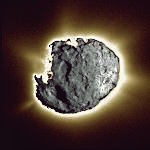 | composite showing surface and out-gassing jets (released March 17th, 2004) |
A last trajectory correction maneuver in June 2003 put the craft definitively on its route to the encounter. Stardust successfully grazed comet Wild-2 by 149 miles (240 km) on Jan. 2nd, 2004 (at 02:40 a.m. EST -07:40 UT). The comet was returning to the farthest point of its orbit after having passed at perihelion -nearest to Sun- by about the end of September 2003. The encounter took place 242 million miles (390 million km) from Earth. The craft took pictures and successfully completed its goal to catch comet's particles. Although taken by Stardust's navigation camera, purpose of which was not science imaging, pictures of the encounter are the best ever of a comet. The comet's nucleus might be in its original state, as comet Wild-2 hovered a long time in a distant Sun orbit before being tossed into the inner solar system. Since that time, it passed close to the Sun five times only. Hence the comet surely features some aspects and materials unweathered since the beginnings of the solar system. Such a nucleus has a billion-year history however and its surface has been interacted by crater impacts and out-gassing. Previously observed nuclei, like the one of the Halley comet, were showing their dark side and might have been weathered by their repeated passages at Sun. Wild-2's surface might be strong enough to support a craft or an astronaut. The gravity there is only 0.0001 g. Jets are likely ice vaporizing through fissures or vents. Comet's dust and particles aggressively sandblasted Stardust shielding during the encounter, as, surprisingly, Stardust did not find dust and particles in greater abundance as it was approaching the comet nucleus. At the contrary it saw loaded and empty layers alternating. The craft instruments performed instantaneous analysis of the cometary particles, as an Aerogel collector catched particles samples. These ones were stowed in a return capsule which will parachute Earth on January 15, 2006, at the USAF Utah Test and Training Range. The mission unfolded particularly well and to the minute. Stardust in now bound to be back Earth two years from now, after three heliocentric orbits. All these data will keep cometary scientists busy for years to come. pictures courtesy NASA/JPL/Caltech
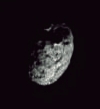 | 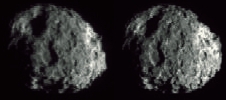 | Wild-2 nucleus is about 3 miles wide (5 km) (left); surface (stereo pair; released March 17th, 2004) (right) |
![]() Further Data Released (June 2004)
Further Data Released (June 2004)
 |  | new views of comet Wild 2 (general view, left; various relief features, right) as released on June 18th, 2004 |
The Stardust team further released data about last January, 2nd encounter during a NASA Space Science Update (SSU), June, 17th. On the other hand, a special issue of "Science", June, 18th, was dedicated to Stardust's findings. Comet Wild 2 was found with much more varieties of landscapes than expected. Most of scientists were still thinking that comets were mostly dirty snowballs. Such various landscape features like spires, craters, or pits, seen at Wild 2, were produced by miscalleneous processes, of them sublimation and impacts. On another hand gas jets emanating from the come were found much more numerous than thought and they were seen reaching far much distances -hence Stardust was heavily sandblasted! Comet gas and particles jetsare forming when Sun shines on icy areas near or just below the comet's surface. Solid ice becomes a gas without going through a liquid phase. It's this process which is called "sublimation". Jets are escaping into the vacuum of space at hundreds of mph (km/h). At last, carbon-nitrogen molecules were found, which supports the idea that comets really were life's primordial blocks carriers at Earth. Carbon-nitrogen bonds are the hailmark of life precursors. The Stardust mission scientists by 2016 revealed that comet ice formed in cold regions beyond the planet Neptune, but the rocks, probably the bulk of any comet's mass, formed much closer to the Sun in regions much hotter
Website Manager: G. Guichard, site 'Amateur Astronomy,' http://stars5.6te.net. Page Editor: G. Guichard. last edited: 1/18/2016. contact us at ggwebsites@outlook.com